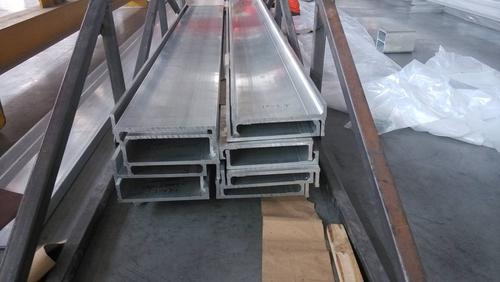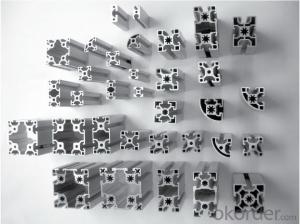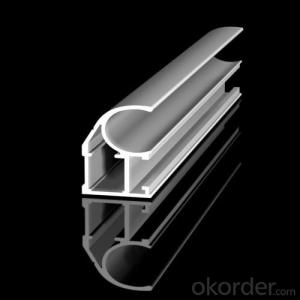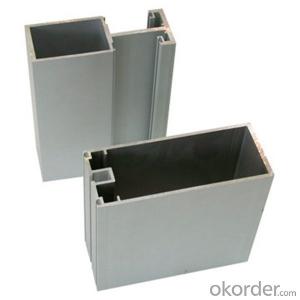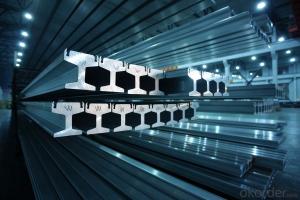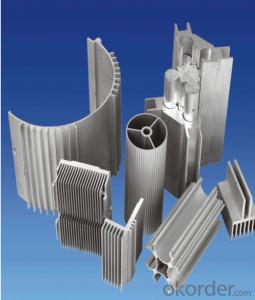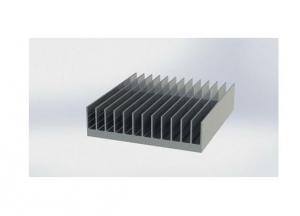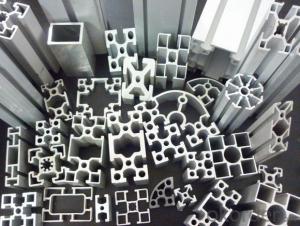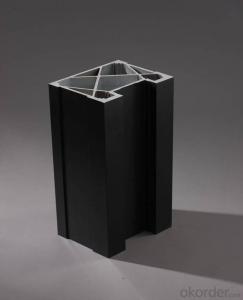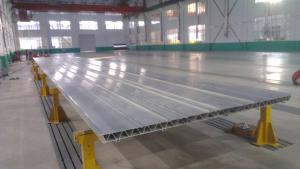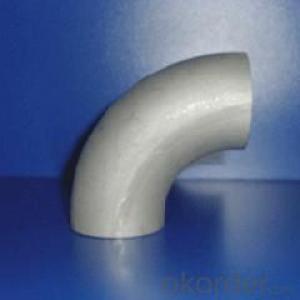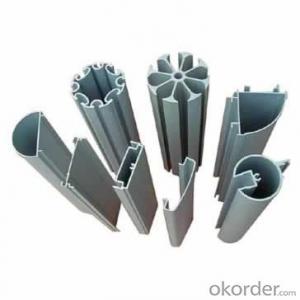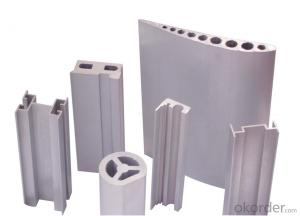Delmar Company Aluminium Profiles for Ship Mast
- Loading Port:
- China Main Port
- Payment Terms:
- TT OR LC
- Min Order Qty:
- -
- Supply Capability:
- -
OKorder Service Pledge
OKorder Financial Service
You Might Also Like
Aluminium Profiles for ship mast
1. Usage:Aluminium Profiles for ship mast
2. Surface: Mill surface treatment
3. Alloy:6082T6 alloy temper
4. Size:various dimensions to meet customer’s requirement
5. Advantage:
The alloy temper of this ship mast is nonheat treatment strengthened alloy which has medium level hardness, good corrosion resistance and weldability. In the atmosphere of sea ocean water, such alloy not only has excellent performance of the general corrosion resistance, and also can eliminate spalling corrosion and inter-granular corrosion.
6. Package:Two pcs of profiles interleaving inserted together to be a couple, ten pcs of profiles wrapped tightly in one bundle.
7. Life time: Last for 50 years
8. Standard: EN755-9 standard
- Q: This question asks for methods to prevent moisture from entering aluminum profiles during the installation process.
- <p>To prevent moisture from getting into aluminum profiles during installation, ensure proper sealing and insulation. Use high-quality weatherstripping and sealants around joints and connections. Install moisture barriers or vapor retarders where necessary, especially in areas prone to high humidity. Keep profiles dry during handling and storage, and avoid installing in wet conditions. Regularly inspect and maintain the profiles to identify and address any potential moisture issues early.</p>
- Q: Can aluminum profiles be an alternative to steel or iron?
- Yes, aluminum profiles can be a viable alternative to steel or iron in certain applications. Aluminum is lightweight, corrosion-resistant, and has high strength-to-weight ratio, making it suitable for various industries including aerospace, automotive, construction, and marine. Additionally, aluminum profiles offer excellent thermal and electrical conductivity properties. However, steel or iron may still be preferred in applications requiring higher tensile strength or extreme durability. Ultimately, the choice between aluminum profiles and steel or iron depends on the specific requirements and constraints of the project.
- Q: What are the different shapes and sizes of aluminum profiles available?
- Aluminum profiles come in various shapes and sizes depending on their application. Some common shapes include T-shape, U-shape, square, round, and rectangular. The sizes can range from small profiles used for decorative purposes to larger ones used in structural applications. The dimensions of these profiles can vary, with width, height, and thickness being the key factors. Additionally, custom profiles can also be manufactured to meet specific requirements.
- Q: How do aluminum profiles handle extreme weather conditions?
- Aluminum profiles possess exceptional durability and resilience, making them highly adept at tackling extreme weather conditions. Their inherent resistance to corrosion allows them to endure harsh weather elements like heavy rain, snow, temperature fluctuations, and intense UV radiation without succumbing to deterioration or corrosion. A key characteristic of aluminum is its ability to form a protective oxide layer, known as aluminum oxide, on its surface. This layer acts as a natural barrier, shielding the metal from moisture, salt, and other corrosive agents found in the atmosphere. Consequently, aluminum profiles remain unaffected by rain or snow, and they do not rust or corrode like other metals. Additionally, aluminum's thermal conductivity enables it to rapidly dissipate heat, preventing any harm caused by extreme temperature changes. Regardless of exposure to scorching heat or freezing cold, aluminum profiles undergo minimal expansion and contraction, which helps maintain their structural integrity and prevents warping or cracking. Furthermore, aluminum profiles can withstand high wind loads, making them suitable for areas prone to hurricanes, tornadoes, or strong gusts. Their lightweight yet sturdy composition allows them to endure significant pressure without bending or breaking. Regarding UV radiation, aluminum profiles exhibit excellent resistance to fading and discoloration. They can effectively withstand prolonged exposure to sunlight without losing their original color or surface finish. This renders them an ideal choice for outdoor applications, such as windows, doors, and facades, where they retain their visual appeal and structural soundness even in extreme weather conditions. In summary, aluminum profiles display remarkable durability, corrosion resistance, thermal stability, and resistance to UV radiation, enabling them to effectively handle and withstand the challenges presented by extreme weather conditions.
- Q: Can aluminum profiles be used in corrosive environments?
- Aluminum profiles can be used in corrosive environments, but it is important to consider certain factors before making a decision. Aluminum is naturally resistant to corrosion due to the formation of a protective oxide layer on its surface. This layer acts as a barrier, preventing further corrosion. However, in highly corrosive environments such as areas with high humidity, saltwater exposure, or acidic conditions, the protective oxide layer may deteriorate over time. To enhance the resistance of aluminum profiles in corrosive environments, various measures can be taken. One option is to choose an aluminum alloy with higher corrosion resistance, such as aluminum alloys with a higher percentage of alloying elements like copper or zinc. These alloys are often referred to as marine-grade or corrosion-resistant alloys. Additionally, surface treatments like anodizing or powder coating can further improve the corrosion resistance of aluminum profiles. Anodizing involves the formation of a thicker and more durable oxide layer on the surface of the aluminum, while powder coating provides an additional protective layer that acts as a barrier against corrosive agents. Regular maintenance and cleaning are also crucial for preserving the corrosion resistance of aluminum profiles in corrosive environments. This includes removing any accumulated dirt or debris that may contain corrosive substances. In summary, while aluminum profiles can be used in corrosive environments, it is essential to select the appropriate alloy, consider surface treatments, and perform regular maintenance to ensure their long-term performance and durability.
- Q: Inquire if aluminum profiles can be recycled locally or regionally and how to find more information about it.
- <p>Yes, aluminum profiles can be recycled both locally and regionally. Recycling aluminum is an efficient process that conserves resources and energy. To find out more about local recycling options for aluminum profiles, you can: 1) Contact your local waste management or recycling center to inquire about their services. 2) Search online for recycling facilities in your region that specialize in aluminum. 3) Reach out to local metal scrapyards, as they often accept aluminum for recycling. 4) Check with local environmental agencies or non-profit organizations focused on recycling for guidance and resources.</p>
- Q: What are the different bending machines or tools used for aluminum profiles?
- There are several bending machines and tools that are commonly used for aluminum profiles. These tools are designed to manipulate aluminum profiles into various shapes and angles to meet specific project requirements. 1. Manual Tube Bender: This is a hand-operated bending tool that is commonly used for smaller aluminum profiles. It consists of a lever and a bending shoe that is used to bend the profile manually. 2. Hydraulic Tube Bender: This machine is equipped with hydraulic power to bend larger and thicker aluminum profiles. It offers more precision and control compared to manual benders, making it suitable for industrial applications. 3. CNC Tube Bending Machine: This is a computer-controlled machine that uses a combination of hydraulic power and computer programming to accurately bend aluminum profiles. It can produce complex and precise bends, making it ideal for high-volume production and intricate designs. 4. Roll Bending Machine: This machine is specifically designed for bending aluminum profiles into curved shapes. It consists of three rolls, with the profile passing through the middle roll while the other two rolls apply pressure to bend it into the desired curve. 5. Mandrel Bender: This tool is used for bending aluminum profiles without deforming or collapsing the inner diameter. It uses a mandrel (a rod inserted into the profile) to support the inner wall during the bending process, ensuring a smooth and consistent bend. 6. Rotary Draw Bender: This machine uses a combination of bending dies and a rotating arm to produce accurate and repeatable bends in aluminum profiles. It is commonly used for bending tubes and pipes, but can also be adapted for aluminum profiles. These bending machines and tools offer different levels of precision, control, and production capacity, allowing manufacturers and fabricators to choose the most suitable option based on their specific needs and requirements.
- Q: Can aluminum profiles be used for stage and event structures?
- Stage and event structures can indeed make use of aluminum profiles. Aluminum, being both lightweight and durable, is a widely utilized material in the construction industry for a range of purposes, including stage and event structures. Aluminum profiles possess versatility, allowing for easy shaping, cutting, and joining to create customized structures. With an excellent strength-to-weight ratio, they are well-suited for supporting heavy equipment and ensuring the safety of performers and audience members. Moreover, aluminum profiles can be powder-coated or anodized, providing both a decorative finish and protection against corrosion. This enhances the visual appeal and longevity of the structures. In conclusion, aluminum profiles are a popular option for stage and event structures due to their versatility, strength, and aesthetic qualities.
- Q: This question asks for an overview of the various types of aluminum profiles that are frequently utilized in the construction of commercial buildings.
- <p>Commonly used aluminum profiles in commercial buildings include: 1. Extruded aluminum profiles, which are versatile and used for window frames, door frames, and curtain walls. 2. Structural aluminum profiles, used for load-bearing structures and support systems. 3. Architectural aluminum profiles, designed for aesthetic and functional purposes like facades and decorative elements. 4. Industrial aluminum profiles, used in manufacturing and assembly lines. 5. Thermal break aluminum profiles, which reduce heat transfer and are used in energy-efficient buildings. 6. Anodized aluminum profiles, offering enhanced durability and corrosion resistance. These profiles are chosen based on specific project requirements, such as structural needs, design aesthetics, and environmental considerations.</p>
- Q: How do aluminum profiles perform in terms of magnetic properties?
- Aluminum profiles do not possess strong magnetic properties. Aluminum is considered non-magnetic as it is not attracted to magnets. This is due to its atomic structure, which does not facilitate the alignment of magnetic domains necessary for magnetic attraction. Therefore, aluminum profiles are generally not affected by magnetic fields and do not have any significant magnetic properties.
Send your message to us
Delmar Company Aluminium Profiles for Ship Mast
- Loading Port:
- China Main Port
- Payment Terms:
- TT OR LC
- Min Order Qty:
- -
- Supply Capability:
- -
OKorder Service Pledge
OKorder Financial Service
Similar products
Hot products
Hot Searches
Related keywords

